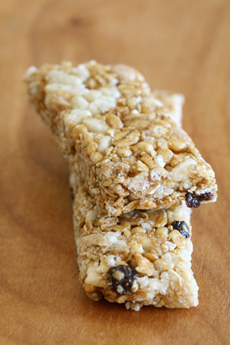

Oats, seeds, nuts, raisins, honey: wholesome snack food. Photo by J. Java | Fotolia.
STEPHANIE ZONIS focuses on good foods and the people who produce them.
|
October 2009
|
 |
Granola Bars
Page 2: Health Food Or Health Fad?
This is Page 2 of a seven-section article. Click on the black links below to visit other sections.
Article Index
Health Food Or Health Fad? Part I
Granola bars are marketed as healthier alternatives to junk food or as an on-the-go meal. But it was a surprise to discover that they’re also sold as products for those with food sensitivities and non-mainstream eating habits.
Granola Bar As Special-Interest Food
Pick up half a dozen bars in any store and look at all their wrappers. You might see product claims such as “no trans fats,” “non-GMO,” “35% of Daily Value of Fiber” and “no high fructose corn syrup,” as well as ingredient listings of “whole grain oats.” These are the “healthier alternative” angle. But many bars also carry descriptors such as “gluten free,” “wheat free,” “dairy-free” and/or “vegan.”
In an era when consumers are splitting into an ever-increasing number of food-related special interest groups, a lot of manufacturers are looking for as broad an appeal as possible. If there are certain foods you don’t want to eat or can’t consume, check the product label.
Granola Bar As Fortified Food
Then, too, there’s the question of fortification. Some granola bars, especially those pitched as meal replacements, are fortified with vitamins and minerals. Rarely, you’ll find a bar fortified with just one or two nutrients. Some people welcome fortification, while some eschew it (one granola bar maker told me that the American diet is overfortified, and there’s something of an anti-fortification movement afoot in the U.S. these days). Again, if it’s important to you one way or the other, check the product wrapper.
Ingredients: All Over The Board
Don’t assume that different products within any one company’s line will have similar ingredient rosters. While my designation that oats had to be one of the first three ingredients in a granola bar for the bar to be sampled for this article was arbitrary, you may have a legitimate dietary requirement for more grains or fewer grams of sugars in a bar. By way of example, Clif Bars, a well-known bar manufacturer, produces some bars that qualified for this article, but also makes a number in which oats were not one of the first three ingredients. Read the labels!
Today’s Trend ~ Tomorrow’s Terror
Remember the 1990s, when soy was the great wonder food and would provide dietary salvation for us all? Well, there’s now something of a soy backlash. Some sources I’ve seen claim that unfermented soy is actually unhealthy for you, especially soy protein isolates (found in a number of granola bars—if this matter is of concern to you, check the product label). Reasons for these claims range from the fact that a large percentage of soy is genetically modified, to levels of aluminum in soy protein isolates caused by the manufacturing process, to the theory that soy has the potential to disrupt several bodily systems, among them the digestive and immune systems. Actual scientific evidence to support these claims appears to be minimal right now, and there’s no predicting what future studies will disclose. As so often happens, boring old moderation may turn out to be the key here.

|




